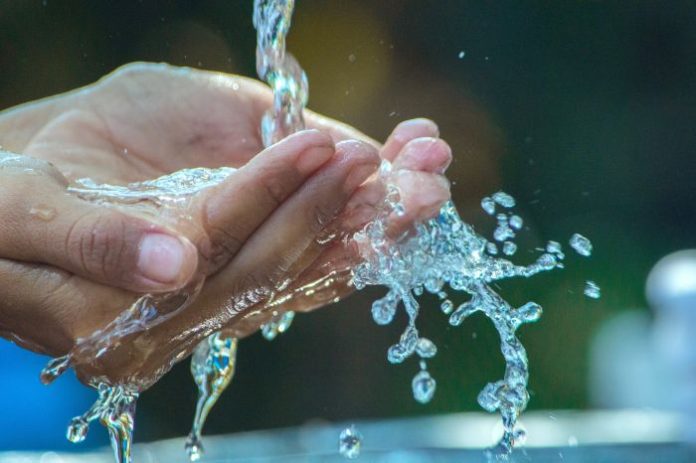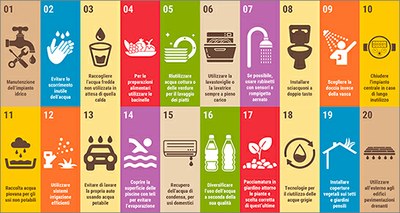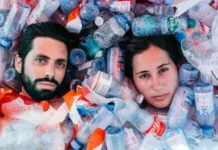
First rule: do not waste water. An indication that is always valid, but even more so in a period of water emergency such as the one we are currently experiencing, marked by the worst drought in the last 10 years. To combat water wastage and make its management more sustainable, ENEA has drawn up a 20-point guide with suggestions and good practices, mistakes to avoid, and also solutions and technologies for saving water (and energy), especially in the residential sector. Key words: in the home, reduce losses and waste and use water more rationally; in general, adopt less water-intensive processes and systems, purification and reuse, efficiency and digitalisation of the aqueduct network, but also good practices in families and schools.

Saving water in 20 points
- Keep the water system efficient and check for hidden leaks: it is estimated that up to 5 litres per day are lost from a dripping tap.
- Close the tap tightly to prevent water from flowing unnecessarily. For example, while we are washing our hands: in one minute we avoid wasting at least 6 litres of water; if we let the water run while brushing our teeth, we waste up to 30 litres (we only consume 1.5 litres if we do not let it run); again, turning off the tap while shaving saves up to 20 litres.
- Collect unused cold water when waiting to receive hot water; carry out operations requiring cold water first (e.g. brushing teeth) and then those requiring hot water (e.g. shaving).
- Same advice in the kitchen, when preparing food or washing vegetables use basins instead of running water. It is estimated that about 6 litres of water per day per capita is consumed for drinking and cooking and at least 40 litres for washing dishes by hand. However, wastage can be as high as 12 litres per minute if the tap is not turned off.
- Reuse water from cooking pasta or washing vegetables to rinse dishes before putting them in the dishwasher or for watering (when not salted).
- Always use dishwashers and washing machines with a full load. It is estimated that a dishwasher load (class A) without pre-wash uses up to 15 litres (7 litres in class A++), while a washing machine load (class A) uses 45 litres. Washing programmes at low temperatures (40-60° C) are also preferred. In addition, the installation of solar panels would avoid electricity consumption to heat the water needed for appliances.
- Prefer, whenever possible, taps with sensors or aerated jet breakers that reduce the flow of water and have greater flushing efficiency, taking care to maintain them (e.g. by using the scraper key).
- Install double-button flushers to save up to 100 litres per day, considering that up to 16 litres of water are used for each use of single-button models.
- Choosing the shower instead of the bathtub saves up to 1,200 litres per year. It is estimated that an average of between 100 and 160 litres of water is consumed to take a bath in the bathtub, while a maximum of 40 litres is consumed to take a 5-minute shower, and even less if the tap is turned off when lathering up.
- Shut down the central system in the event of prolonged periods of non-use (e.g. when leaving on holiday).
- Install rainwater harvesting systems for non-drinking uses (washing toilets, washing cars) and for watering (rainwater is less hard and more agreeable to plants), avoiding it during hot hours to reduce evaporation. In Italy, an average of about 800 mm of rain falls per year. This means that on an area of around 80 m2 the water needed for one person for a year can be collected.
- Use timed, drip or sub-irrigation systems for irrigation because of their greater efficiency.
- Avoid washing your car using drinking water, this way we could save 400-500 litres.
- Cover the surface of pools with tarpaulins to prevent evaporation.
- Recovering condensation water from air conditioners or the dryer, for domestic use, such as for the iron.
- Diversify the use of water according to its quality (drinking, rain, grey, black – see fig. 2).
- Use, where possible, technologies for the reuse of grey water, i.e. water generated by personal hygiene operations. A dedicated system to recycle water from showers, washbasins and bathtubs and, in some cases, from condensation from air conditioners or boilers, ensures its treatment for subsequent use for ‘secondary’ uses such as flushing toilets, watering green areas, washing operations.
- In the garden, around plants, mulch adequately to keep as much water in the soil as possible; also prefer plants that need less water and take care not to water impermeable areas.
- Installing vegetation covers on roofs and roof gardens. These can absorb up to 50% of rainwater and slow down rain runoff into the city’s water system, reducing the possibility of flooding in the event of heavy rainfall. Green roofs also promote thermal insulation of the roof, reduce particulate matter and promote a more pleasant microclimate by reducing the albedo effect.
- On surfaces outside buildings, use drainage pavements in order to preserve the naturalness and permeability of the site, encourage groundwater recharge, reduce subsidence and mitigate the effect known as the heat island.
Figures
According to ENEA estimates, in homes, the energy needed to produce hot water accounts for about 25% of the total energy used, while the average consumption of water for civil (residential and tertiary) use accounts for about 20% of total consumption, with a per capita water supply (net of leaks) of about 200 litres per inhabitant per day.
“One of the biggest problems in our country is the lack of infrastructure and the inefficiency of the aqueduct network,” emphasises Luigi Petta, Head of the ENEA Laboratory of Technologies for the Efficient Use and Management of Water and Wastewater. Despite its high water supply – guaranteed by 7,594 watercourses, 324 lakes, more than 1,000 underground aquifers, and 526 dams that collect about 11% of rainfall – the Italian network in fact loses an average of 41.2% of the water injected, with peaks of 48% in national macro-environments. Even in the most virtuous areas, this percentage never falls below 20%, compared to much lower values in Europe (6.5% in Germany)’. According to ENEA estimates, the efficiency and digitalisation of the aqueduct network would allow energy savings of up to 25%.
It is also crucial to save water in the productive sectors; in our country in particular, fresh water withdrawals for agricultural uses account for about 50 per cent of the total water requirement. This means that, in order to cope with water shortages such as this one that are damaging agricultural production, it is essential to make irrigation techniques more efficient by using those with greater efficiency (subsurface irrigation, under-irrigation, drip irrigation) and to focus on research and technological innovation to encourage the reuse of treated wastewater. With this objective in mind, ENEA has developed a technologically advanced prototype that can monitor the quality of purified effluents in real time and establish their optimal uses, including first and foremost the irrigation of cultivated fields, with benefits in terms of greater water availability, nutrient supply, and the consequent reduction of chemical fertilisers, improving environmental sustainability, quality and safety in the purification chain.
“Water is a precious resource. The problems related to its availability, whether they be related to lower rainfall on a seasonal basis, drought, or excess demand compared to the usable water resources, affect many areas of the national and European territory and require actions at the local and multi-sectoral level, to be planned over the long term avoiding the use of emergency-type intervention logics,’ Petta emphasises. “In addition, growing urbanisation and increasingly high living standards are further critical factors that make optimal and careful management of the resource necessary”.






































